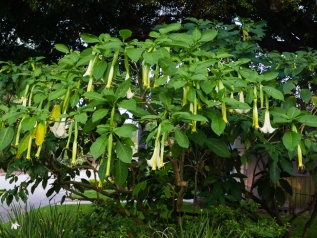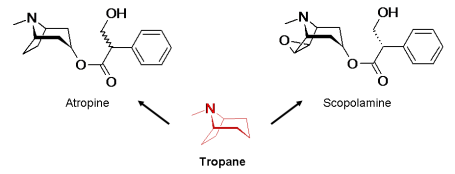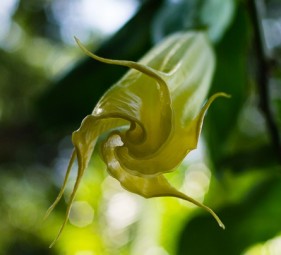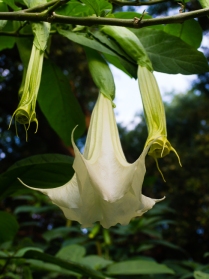Often times the common names given to plants are due to their physical characteristics. Take the Brugmansia genus, for example, its common name is “Angel’s Trumpet.” By taking a look at these photos you can certainly see why it could be called such. It looks angelic, and certainly has a resemblance to an instrument in the Pearly Gates Brass Band – particularly Gabriel’s horn. Brugmansia truly are pretty trees, and half a dozen different species grow in warm climates throughout the south eastern United States and Central and South America – throughout the world, really. The ones I am familiar with reach heights of about 12-15 feet with equally wide canopies that showcase their impressive and prolific blooms. But if we named things after their chemical properties, “Angels’s Trumpet” would quickly be transformed into “Devil’s Trumpet” – which is a nickname given to one of Brugmansia’s cousins, Datura.
What makes Brugmansia so devilish are its tropane alkaloids. We’ve mentioned alkaloids before, and they are simply nitrogen containing chemicals – usually secondary metabolites – made by plants. And I’ve mentioned tropane before, too, but it was a while ago. Tropane is just a specific bicyclic ring structure – N-Methyl-8-azabicyclo[3.2.1]octane to be exact. Why the long and funny name? Well, it tells organic chemists how to draw it. The “aza” tells me it has a nitrogen, “[3.2.1.]” means it has 3, 2, and 1 carbons between the two fused “bicyclo” rings made up of 8, “octane”, atoms. Throw a methyl group onto the nitrogen in that 8-position and we’re done. See? Simple. And people think organic chemistry is hard.
So now that the general stuff is out of the way, let’s get to the specifics. What tropane alkaloids are so dangerous, especially from something so pretty? Scopolamine and atropine, to name two. I’ve discussed scopolamine before, and called it evil. Nothing much has changed, it still is. And you’ve probably heard of atropine as the injected drug used to jump start your heart during resuscitation. Both are muscarinic acetylcholine receptor antagonists and block the receptor’s activity. They differ slightly however, in that scopolamine has a bit more central nervous system (CNS) activity than atropine. The muscarinic receptors mediate activities in the parasympathetic nervous system (PNS), whose activities are remembered by the mnemonic SLUDGE, which I’ve discussed a bunch here, here, here, and here. But it’s worth repeating: Salivation (drool), Lacrimation (tears), Urination (pee), Defecation (poo), GI upset (diarrhea) , Emesis (puke). All of your gross bodily fluids. Nice. Antagonism of these receptors stops the above, which is why drugs for overactive bladders are muscarinic acetylchloine receptor antagonists.
Scopolamine is used to treat nausea and motion sickness, and given to pilots and astronauts. But too much, and it has CNS effects, including hallucinations and amnesia. And from what I’ve read it’s not a pleasant experience, and not one that gets repeated often (Some experiences can be read in the scopolamine post). Atropine, used to kick-start the heart, has side-effects of dry mouth, blurred vision, and in high enough doses dissociative hallucinations and tachycardia (high heart rate).
So despite the seemingly unpleasant side-effects, scopolamine and atropine have a good side, even life saving. But because Brugmansia is a natural product, tropane alkaloid content can vary wildly by species, location, or weather. You name it, and it can change the proportions and concentrations of scopolamine and atropine present in the leaves and flowers of the Angel’s Trumpet. And this isn’t a good thing. People like to know what type of dose they are getting if they consume something. It’s probably why we started producing and packaging 300 mg aspirin tablets instead of handing someone a chunk of willow bark. With all that said, would people willingly ingest Brugmansia? You know it!
Ancient peoples have ingested and used plants and their chemical constituents for therapeutic and ritualistic purposes for thousands of years, and Brugmansia is no different. Shamans in the Andean mountains of Northern Peru thought that it contained spiritual power and used it for divinations and initiation rituals (1). They believed that the flowers and juices of the plant would help one “see” good and evil, and aid by clearing the mind.
Would people do the same today? Why do I type silly questions? Of course they do. The downside is that Brugmansia use is often by children, either accidentally because the flowers are so pretty and they don’t know any better, or on purpose because kids heard that you could get high off of it and they couldn’t score any nutmeg. Either way, it’s dangerous at best and deadly at worst.
An example is three separate cases of teenagers making Angel’s Trumpet tea for the sole purpose of “getting high” (2). Each one experienced vivid and bizarre hallucinations, such as being “attacked by hostile cherries in his room.” On hospital admission they were visibly agitated and incoherent. The scary part is that each had retrograde amnesia, meaning that they could not remember what happened after they ingested the tea. Scary indeed.
The treatment for this type of poisoning is something that we’ve already talked about before: physostigmine. Physostigmine is an acetylcholinesterase inhibitor, which means that it stops the breakdown of acetylcholine, which is our endogenous ligand (our body’s natural drug) for the acetylcholine receptor. In short, it amps up our body’s acetylcholine and competes with scopolamine for the acetylcholine receptors. So a common course of treatment is physostigmine to stop or reverse the actions of scopolamine and atropine, along with a benzodiazepine or some other sedative to calm the individual (3). So aside from the cardiac risks and stupid-things-you-do-but-won’t-remember to escape the killer cherries, you’ll probably be OK and discharged from the hospital in a few days.
Brugmansia definitely poses a threat, one that people purposely plant in their gardens and front yards, and there are those that would like to see them disappear. Australia is one such country that sought to ban a Brugmansia species. But we have threats all around us, every day. Eradication is not the solution . . . Education is. And since adolescents are the usual suspects, it is on the parents to teach them. My girls were in their single-digit years when I taught them about the dangers of Angel’s Trumpet, and is something I still teach them. I’m probably the opposite of a forager – instead of pointing out what is edible, I only point out what is poisonous (though I’m sure foraging instructors do the same – If you’re interested in foraging, and/or in Scotland, check out www.gallowaywildfoods.com).
So remember, education, not eradication. And watch out for the killer cherries.
References:
1. Feo, Vincenzo De. “The Ritual Use of Brugmansia Species in Traditional Andean Medicine in Northern Peru.” Economic Botany 58.Sp1 (2004): S221-229.
2. Göpel, Christopher, Claudia Laufer, and Alexander Marcus. “Three Cases of Angel’s Trumpet Tea-induced Psychosis in Adolescent Substance Abusers.”Nordic Journal of Psychiatry 56.1 (2002): 49-52.
3. Isbister, Geoffrey K., Patrick Oakley, Andrew H. Dawson, and Ian M. Whyte. “Presumed Angel’s Trumpet (Brugmansia) Poisoning: Clinical Effects and Epidemiology.” Emergency Medicine Australasia 15.4 (2003): 376-82.




Your chatty, light-hearted presentation of a potentially problematic plant in our yard saves the real kicker for last. The solution to all of this world’s problems: education.
Thanks
Dad
You have probably seen the Vice magazine report of Colombia prostitutes and thief gangs intoxicating rich people or hapless tourists with Angels trumpet extract into a sleepwalking state where the victims become vulnerable to mind control techniques. If they survive it, they typically have no recollection what happened the night before – i.e. that they visited dozen of ATMs to cash out their cards while acting seemingly rational, or helped the gang to load a van with the contents of their own house…
Oh yeah. I’ve read that approx. 25% of hospitalizations in Colombia are due to scopolamine a.k.a. Devil’s Breath. Sounds a bit inflated, but even if so, that’s huge!
From zombies, to truth serum, to crime, to legendary hallucinations…scopolamine has got it all. Probably why it’s one of my favorite drugs.
“… one of my favorite drugs.”
This drug is more than just a lynch key for Human Trafficking, it is the most effective Pedo-Snuff (((blackmail))) weapon known to civilization. This is how control freaks can get a subordinate to murder their first born while laughing. If that does not sober one up then we are better off dead.
My take on this is the go to drug for Pedovores and Sadistic sick (censored).
Even amateur slave traders must be hunted down like the rabid dogs they are.
Say, was Bill Cosby more than a papered doctor? Because he played on in real life.
For information We should not forget that , this plant is growing maturally all around the world and as soon as a fire or a volcano burn the lands. One of The first plant to go out is the datura. The seeds seams resisting to the heat and will populate the ground of haches.
I have been dosed with scopo the after effects are deteriorating my brain the nightmares are absolutely horrible it’s been 3 years and I still have major problems with memory and depression
I really loved this post! Perfect balance of intellectual science info and humor. 🙂
This article has the ability to save more than just human lives, but humanities dignity.
Education and wisdom is a Human Traffickers worst nightmare. Humbled respect Justin.
Hat tip with a smiling wink.
Question! If I have a this plant in my backyard and want to start my own garden instead, do these compounds make it to the soil or strictly reside in the flowers/leaves/seeds?
If they do make it to the soil, I know they’ll break down at some point, but how long does that process take? Would I be safe to plant something edible on that same soil after removing the plant?
You’re fine to plant them. Some plants can send poisons into the soil, but it’s really minuscule. Then you factor in the vegetable taking it out of the soil and storing it in roots and leaves and that’s even tinier. I don’t know what “miniscule x tiny” equals, but it’s not enough for you to notice or harm you. Good luck with your new garden!